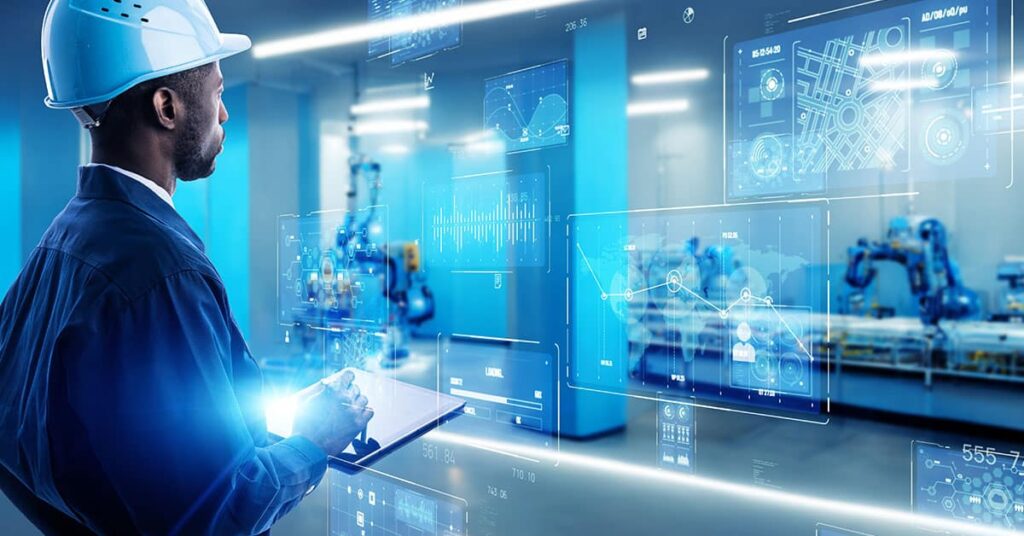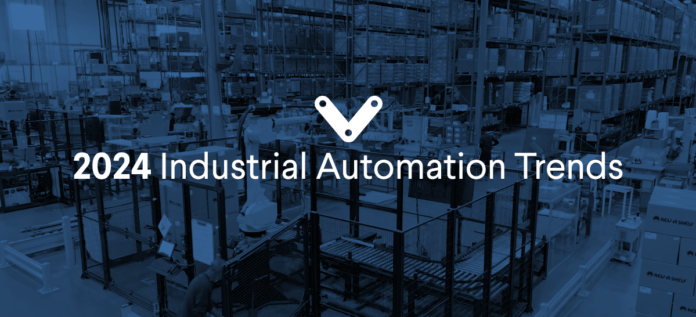The landscape of industrial automation is undergoing a transformational evolution as we head into 2024. Advancements in technologies such as artificial intelligence (AI), collaborative robots, and IoT integration are some of the key factors driving this evolution. Those businesses that successfully utilize emerging technologies and automation will have an advantage as labour challenges, higher demand, and tighter budgets continue to plague businesses. The following sections delve into the industrial automation trends that are shaping the future of manufacturing for 2024.
The Rise of Digital Technologies in Manufacturing
Advanced Generation AI, digital twins, and 4D vision are new-age technologies that are reshaping the manufacturing world. These technologies give greater efficiency to various aspects of production to make the business finer and more flexible. Bearing firms of all sizes are purchasing these innovative digital products as they become more affordable and common.
With the application of these enhanced technologies, producers are able to integrate their systems, enhance efficiency, and lessen wastage. The use of technology is not just an innovation; it is a survival strategy that businesses need to embrace in order to survive in the competitive world of 2024.
The Virtual Replicas Revolutionizing Production
Digital twins are defined as virtual look-alikes of a tangible system, an object, or a process; it is projected that more of it will be used. With these, virtual models are valuable since they provide a way through which product emanations and designs can be enhanced at a faster pace, hence speeding up market traffic. Their enhanced outcome of digital twins includes the reduction of errors in production lines before actual production.
They also improve the training of employees through the roles and raise sustainability by minimizing scrap waste. In addition, they are also used to project problems that are likely to occur in the systems so that they can be solved before they occur; this will help reduce downtime and, therefore, make the systems more effective.
The Transformative Power of Generative AI
Generative AI is transforming businesses by providing a comprehensive understanding of ongoing activities and predicting equipment breakdowns in manufacturing through data analysis. The synergy between generative AI and automation holds transformative capabilities for businesses. AI will persist as a valuable resource for product development, while automation will catalyze to bring these products to life.
This integration allows manufacturers to streamline operations, reduce costs, and improve product quality. The transformative power of generative AI lies in its ability to learn and adapt, making it an indispensable tool for businesses looking to stay ahead of the curve in 2024.

4D Vision: Enhancing Robotic Capabilities
The integration of vision technology with robots has brought substantial value to businesses, enhancing the efficiency of processes. Vision serves as an integral sensory component for robots, enabling them to perform tasks while promoting and ensuring safety within their operational environment.
Advancing beyond conventional vision technology, the emergence of 4D vision has revolutionized automation processes by incorporating artificial intelligence (AI) and a heightened level of human-like elements. The enhanced capabilities of 4D technology facilitate faster image processing, thereby significantly accelerating the speed at which robots execute automated applications. This advancement in vision technology is set to further enhance robotic capabilities in 2024.
Also Read About: Why New Summit Industries Limited is Leading the Industry in Excellence
Beyond the Warehouse: AGVs and AMRs
Warehouses have been known as the primary application area for AGVs and AMRs, but in recent times, industry applications have been on the rise. It has already been seen that AGVs and AMRs are being implemented in operations other than warehouse automation, which has posed better opportunities for improvement.
Most companies are integrating AGVs with other types of robots, known as cobots, for flexibility and manoeuvrability around the barriers and general effectiveness in the performance of the tasks. This trend is also expected to persist in the near future, given the effort that most companies apply as they seek to minimize the use of human resources. The growth and further use of AGVs and AMRs not only in warehouse spaces is one of the trends in industrial automation for 2024.
Speed to Automation: A Crucial Differentiator
Time-to-market for automation solutions is getting critical as more and more manufacturers find the necessity of automation technology. Every business, large and small, is searching for ways to automate as automation is now a necessity for organizations to survive. Businesses that are in a position to employ the system to transform their production rapidly will have a competitive edge over others.
Also, more organizations at different levels of the industry, without prior automation efforts, are warming up to the process to ensure that they compete effectively and adopt efficiency. The rapidity of automation also measures how fast new technologies can be implemented in businesses and integrated into existing processes.
Machine Learning and Predictive Analytics: The Future of Decision Making
The use of machine learning and predictive analysis of the large volume of data being generated by automated systems is now a critically significant area of focus in the field. These technologies make it possible for leaders to enhance decision-making processes with the analysis of data, enhance the ability to predict equipment failures and enhance overall processes in their operations.
Some aspects that can be analyzed may be beyond human ability, but they can provide helpful information about operations and cut down on costs. Predictive maintenance is conducted with the aid of predictive analytics so that possible problems are identified beforehand, therefore avoiding the need to fix a problem after it has disrupted the working of an organization. The future of decision-making in the automation of the industry environment is the use of machine learning and predictive analytics.

The Impact of IoT Integration on Industrial Automation
Thus, IoT has been found instrumental in managing the various systems and devices stemming from the automation of the manufacturing process by networking the overall environment. By integrating IoT into the industrial processes, data statuses may be observed as they occur, and communication between machinery is optimized, hence improving efficiency and always reducing possible downtimes.
Through proper IoT application, manufacturing companies are able to perform an analysis of their activities, find out areas of inefficiencies, and correct the issues. The impact of IoT integration in industrial automation is profound, as it enables businesses to optimize their operations, reduce costs, and enhance productivity. As IoT technologies continue to evolve, their role in industrial automation will become even more critical in 2024.
Collaborative Robots (Cobots): Redefining Human-Robot Interaction
Cobots are revolutionizing the social interface of humans and robots in the industrial environment. It’s important to note that cobots are intended to collaborate with human employees, increasing production efficiency and decreasing the risks inherent to the workplace. They include incorporated sensors and AI that aid in efficiently executing duties based on the circumstances surrounding them.
The adoption of cobots is on the rise as there are many benefits, including the fact that cobots can easily be fitted into production lines, they are versatile in the tasks they do, and they are safer for human operators than industrial robots. Thus, in 2024, cobots are expected to be embraced even further by businesses in their bid to offer more automation solutions that are still personal.

Sustainability and Green Manufacturing through Automation
The use of automation is aiding sustainability and managerial strategies towards green manufacturing. Using different means of automation in a company frees up resources and thereby leads to a decrease in environmental waste. Energy consumption and emissions can be managed and regulated through automation, reducing resource waste.
These are complemented by even superior technologies, such as the application of Artificial Intelligence and the Internet of Things, that augment the control and monitoring of manufacturing procedures much more effectively. Indeed, more manufacturing companies are outlining sustainability as a strategic imperative, which has implications for the use of automation to drive green manufacturing. Emphasis on energy saving and environmental conservation in production processes remains a major growing trend in industrial automation in 2024.
Conclusion
The future of manufacturing employs several industrial automation trends that will prevail in the year 2024. It’s a brand new world from high-tech digital technologies & the generative AI revolution to the beyond-the-warehouse evolution of AGVs & AMRs; these innovations are enabling true, optimized efficiency, agility and sustainable growth for markets.
As more firms embrace and work with the above-stated technologies, they will transform the manufacturing environment as they hold a competitive advantage. Many of the businesses venturing into the future will need to ensure that they adopt new trends that are likely to be released in the near future, including embracing automation. By leveraging the power of industrial automation, manufacturers can optimize their processes, reduce costs, and enhance their overall productivity.
For More Articles Click the: Ezinee.co.uk
FAQ’s
What are the key trends in industrial automation for 2024?
Key trends in industrial automation for 2024 include:
- The rise of digital technologies such as generative AI, digital twins, and 4D vision.
- The expansion of AGVs and AMRs beyond warehouse automation.
- The importance of speed to automation.
- The integration of machine learning and predictive analytics.
- The impact of IoT.
- The adoption of collaborative robots (cobots).
- The push towards sustainability and green manufacturing practices.
How are digital twins transforming manufacturing?
Digital twins are virtual replicas of physical systems, objects, or processes that enable rapid product iterations, improved product quality, enhanced training, increased sustainability, and predictive maintenance. By identifying flaws and optimizing designs before actual production, digital twins help manufacturers reduce waste, improve efficiency, and bring products to market faster.
What is the role of generative AI in industrial automation?
Generative AI provides a comprehensive understanding of ongoing activities and predicts equipment breakdowns through data analysis. The synergy between AI and automation allows for streamlined operations, reduced costs, and improved product quality. AI helps in product development, while automation brings these products to life, making the integration of AI a crucial element in industrial automation.
How does 4D vision technology enhance robotic capabilities?
4D vision technology integrates artificial intelligence and human-like elements into vision systems, enabling faster image processing and enhanced safety. This technology allows robots to perform tasks more efficiently and accurately, promoting greater operational efficiency and safety in automation applications.
What are the benefits of using collaborative robots (cobots)?
Collaborative robots, or cobots, are designed to work alongside human workers, enhancing productivity and safety. Cobots are flexible, easy to integrate into existing workflows, and equipped with advanced sensors and AI capabilities. They improve safety by performing dangerous tasks and can adapt to various environments, making them valuable assets in industrial automation.
How does IoT integration impact industrial automation?
IoT integration connects various automation systems and devices, enabling real-time data monitoring and enhanced communication between machines. This connectivity improves operational efficiency, reduces downtime, and allows manufacturers to optimize processes more effectively. IoT technologies provide deeper insights into manufacturing operations, facilitating better decision-making and resource management.



